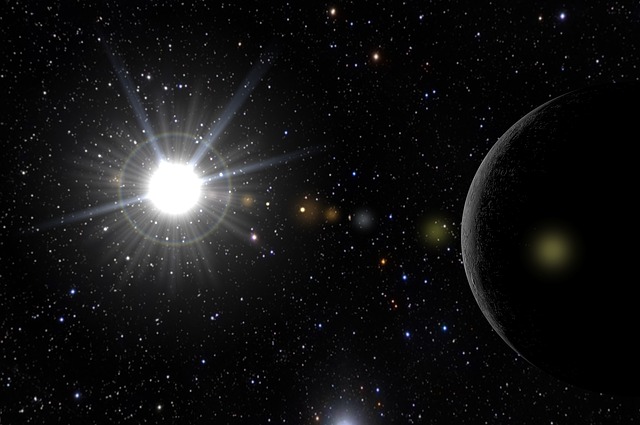*This post may contain affiliate links. This means we may make a commission if you purchase an item using one of our links*
If you’ve looked even slightly into what tidal locking is you’d probably be well aware that our moon is tidally locked to Earth, which in simple terms means we only see one side of the Moon’s face at all times.
It’s often believed that due to Mercury’s relatively close proximity to the Sun, it’s likely a tidally locked entity however, this isn’t quite the case.
Mercury is locked to the Sun following a 3:2 orbital resonance, meaning it rotates 3 times around its axis every 2 times it orbits the Sun or 1.5 every full orbital cycle. As a result even though the Sun’s gravitational pull does affect Mercury (which I’ll explain in a little more detail below) it technically is not tidally locked to the Sun.
Can Planets Be Tidally Locked?
Table of Contents
Yes they can, in fact we now know that the dwarf planet Pluto and its moon Charon are tidally locked to each other. Furthermore, the Earth is projected to tidally lock itself to the Moon too. This is taking into account that every year our planet is spinning slower around its axis, at a rate of about 1.4 milliseconds every century.
Theoretically this means Earth will tidally lock itself to the moon in the not too distant future, in an estimated time of around a few billion years.
With that being said chances are it’ll be caught in the inflation of the Sun near the end of its life cycle before tidally locking to the moon.
Of course Venus has a smaller chance due to the lack of a moon and Mars isn’t tidally locked either but, taking into account the Pluto, Charon example, if a satellite is present, it is technically possible that all planets would eventually become tidally locked.
What Is Orbital Resonance?
Orbital resonance is when two celestial bodies exert regular gravitational burst upon each other resulting in either a stable or unstable resonance between the 2 or more celestial bodies.
Some examples include Pluto and Neptunes resonance of 2:3 and the resonance of Jupiter’s moons Ganymede, Europa and Io of 1:2:4.

For entities with an unstable resonance, one example being Saturn’s inner moons, they can cause objects within their vicinity to be ejected, which is why the inner most moons of Saturn have created gaps within the gas giants’ rings.
On the other hand, a 1:1 resonance between a body and moon is one element scientists have used to define a planet. When two celestial have a 1:1 resonance this means that debris won’t be able to fall within the orbit of either celestial object as the debris will either get flinged out or crash on to the surface of either entity.
Is Mercury Tidally Locked To The Sun?
No, Mercury is not tidally locked to the sun as it follows a 3:2 orbital pattern as mentioned earlier on. However, it does make sense that some would assume that Mercury is tidally locked as older books (before 1965) some scientists did make these assumptions. Now of course we know it isn’t.
You can say that Mercury is under an elliptical tidal lock due to its 3:2 spin resonance with the sun. As for the reasons why, we don’t exactly know but, there are a few theories that scientists have looked into.
Why Does Mercury Have A 3:2 Orbital Spin Resonance?
Theory #1
One theory that was tossed aside suggested that the friction from Mercury’s core mantle could be the reason why however, due to the pinpoint accuracy of the viscosity values required of the planet, many deemed this theory to be highly unlikely.
Theory #2
Another theory suggests Mercury initially evolved from a much higher eccentricity then we observe today, which simply means the planet likely has started following a far more normal form of resonance in comparison to what it may have been many many years ago.
Theory #3
And the final theory that’s still somewhat plausible has to do with the planet evolving from a retrograde rotation which suggests Mercury used to orbit in the opposite direction to the sun spinning on its axis and has now potentially decelerated due to the tidal torques resulting in the planets current resonance.
Of course these are just theories as scientists still aren’t all too familiar with the dissipation process of planets and stars but, going by the consistent numbers that have been developed over the years, the above 3 theories are the most probable reasons for why Mercury follows an elliptical tidal orbit and not a 1:1 tidal lock.
Summary
In summary Mercury is not tidally locked to the sun as it’s currently spinning around its axis once every 1.5 times its orbit. On top of that there isn’t any concrete theory as to why Mercury is on a 3:2 spin resonance due to the lack of information scientist have about the energy dissipation of planets.
I guess you could say there is some potential in Mercury eventually tidally locking to the Sun however, in our current climate and lack of knowledge on where Mercury may have come from (in regards to its original orbit), it just leaves us with more questions than answers.
Hopefully this article was helpful in figuring out if Mercury is genuinely locked tidally to our Sun or if it may become fully locked further down the line.

